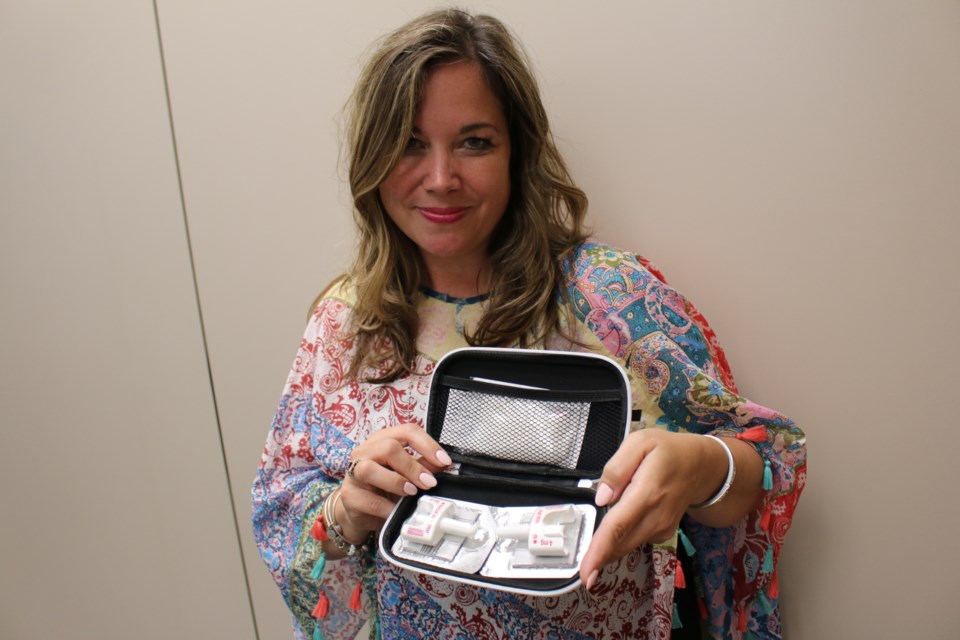There’s a new drug in town named for its characteristic hue. It's called purple heroin and it's a dangerous cocktail that includes synthetic opioids.
Collingwood and The Blue Mountains OPP announced purple heroin was discovered by officers in Collingwood during an investigation. According to media officer, Martin Hachey, the OPP cannot release further details about that investigation.
Purple heroin has been popping up in communities surrounding Simcoe County over the past few months. According to police it has been found to combination of heroin, morphine, fentanyl and carfentanil.
The mix can vary based on the dealer cooking it, but any combination of opioids is dangerous. Fentanyl and carfentanil are powerful synthetic opioids. According to the Simcoe Muskoka Health Unit, Fentanyl is 100 times stronger than morphine and 40 times stronger than heroin. Carfentanil is much worse.
“It’s not intended for human consumption,” said public health nurse Mia Brown, who is involved with the Simcoe-Muskoka Health Unit Inquiry and Substance Misuse Program. “It’s intended for veterinary use. It’s a sedative to tranquilize large animals.”
Carfentanil is 100 times more potent than fentanyl and 10,000 times more potent than morphine.
According to Brown, those who have overdosed on something as potent as carfentanil often require more than the typical two or three doses of Naloxone. In every overdose case, even those where the drug user received a Naloxone treatment, medical attention is necessary, said Brown.
“It’s important that people using illicit drugs in the community are aware of our messaging around staying safe while using,” said Brown. “They should carry a Naloxone kit with them, never use alone and start low and go slow.”
Naloxone kits are available for free from any pharmacy or Simcoe-Muskoka Health Unit clinic, and a health card is not required to obtain a kit. Each kit contains two doses of the drug Naloxone, which will temporarily reverse the effect of an opioid overdose.
“Not using alone is really important,” said Brown. “Someone can call 911 if they are with someone who overdoses. They can also give them Naloxone and stay with them until help comes.”
Early overdose symptoms include deep sleep, slow and/or irregular breathing, blue around the lips or fingernails, and snoring or gurgling sounds. If you suspect someone has overdosed, call 911 immediately. If there’s a Naloxone kit, administer the treatment, then stay until help arrives.
The Good Samaritan Drug Overdose Act provides some legal protection for people who experience or witness an overdose and call 911 for help. The act will protect someone from possession charges and breach of conditions charges regarding simple possession of a controlled substance.
Brown said the health unit gets weekly updates on hospital visits relating to opioid overdoses, and she has noticed an increase in opioid-related visits since the start of the summer.
According to Gilbert Centre statistics, the rate of deaths from opioid-related causes, as well as emergency-room visits from opioid poisoning, are much higher in Simcoe Muskoka than the provincial average.
Statistics also show that the crude rate (per 100,000 people) for opioid overdose ER visits in 2017 was highest locally in Barrie, Penetanguishene, Orillia and Midland, based on 2016 population estimates. Barrie led the way with 204 opioid overdose visits, followed by Orillia (42), Midland (22), Innisfil (19) and Bradford West Gwillimbury (15). Penetanguishene had 13.
The health unit is working with local emergency responders including fire departments and OPP to make sure those responding to emergency calls are equipped with Naloxone kits. The Collingwood Fire Department recently started carrying the kits on the fire trucks.
The Simcoe Muskoka Health Unit has an opioid strategy that includes partnerships with community emergency workers and hospitals. The health unit released a report titled: An Action Plan for Our Communities.
In the report, the health unit states the connections between hospitals, police and paramedic services have gone a long way in monitoring increases in overdoses. A new anonymous reporting site also allows members of the public to report suspected laced drugs, and provides information for safe use, treatment and overdose prevention.
When it comes to harm reduction, Naloxone is being widely distributed in the region, and the health unit report further states there will be a feasibility study soon to determine if and where safe consumption sites are needed and overdose prevention sites are also possible.
“Naloxone is one strategy in our large drug strategy to save a life,” said Brown. “If we didn’t have it, we would certainly see more deaths than we have.”
The plan also includes treatment options such as the newly opened Rapid Access Addiction Medical Clinic (RAAM) at Royal Victoria Regional Health Centre in Barrie.
Finally, the plan suggests the best way to reduce the crisis is through prevention. The health unit is working with the school board to collaborate on mental health wellness and early childhood issues. For more on opioid use, treatment and safety, click here.


